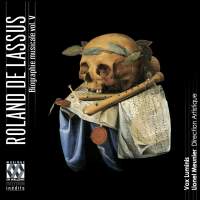Texte paru dans: / Appeared in: |
|
|
Outil de traduction ~ (Très approximatif) |
|
|
Reviewer: J.
F. Weber The first four discs of this interesting musical biography of Orlandus Lassus seemed to cover the course of his life, concluding with his old age (Fanfare 38:5; earlier installments in 38:2 and 35:6). But this final program is subtitled “Lassus the European” and recaps his adult life in his publication history. He is called a European by virtue of his wide fame as a composer, the variety of texts he set (Latin, Flemish, French, Italian, German), and the number of publishers that brought his work to the public. This time the essay walks through the publishers one by one, characterizing them by city and by the content of their offerings. The list begins with both Gardano and Scotto in Venice in 1555 with his first book of madrigals, which went through 14 reprints in the next three decades, then with Dorico in Rome with villanellle, and Tilman Susato in Antwerp with a trilingual collection of works (Italian, French, Latin). Just a year later, another Antwerp publisher, Jan Laet, brought out his first book of motets. It would be tedious to reduce a 10-page essay to a mere list of publishers, but the first German publisher was Montanus & Neuber in 1562 with a book of motets. In 1567 the Munich publisher Adam Berg began a long association with Lassus by bringing out a book of German songs. While these publishers usually devoted whole volumes to Lassus, Le Roy & Ballard in Paris made a great success of offering collections of music by contemporary composers with the works of Lassus featured. After 1564, however, they offered over 20 volumes of works by Lassus alone. The narrative concludes with the Musica dei donum published by Widmanstetter in Graz and the posthumous collection of over 500 motets, Magnum opus musicum, collected by his two sons and published by Heinrich, the successor to Berg. The 20 short pieces on the disc (only two of them fractionally over five minutes) are chosen from the published volumes as they occur in the essay. Altogether they sample his published music in order of appearance. The choices are striking for their unfamiliarity, down to the last two books, represented respectively by Exaltabo te Domine and Domine quid multiplicati sunt (for 12 voices, one of only two such motets), neither of which are found in any recent reviews here. This survey may be regarded as a view of the composer’s development, although it is a commonplace to say that the order of publication cannot be equated with the order of composition, which remains largely unknown. The 20 selections are almost evenly divided between motets and secular pieces. The unfamiliar pieces contained in this disc, like the other four discs, make the set more valuable than a duplication of motets and songs that any collector would already have. No Lassus devotee should ignore this production. | |
|
|
|
|
Cliquez l'un ou l'autre
bouton pour découvrir bien d'autres critiques de CD |
|




